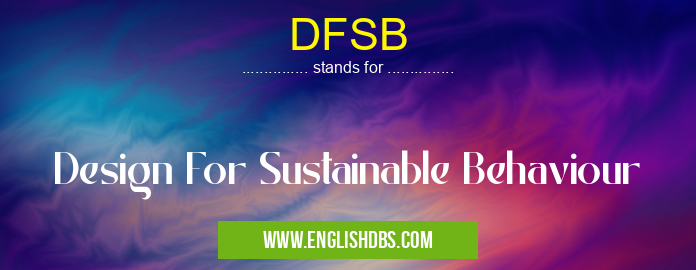What does DFSB mean in UNCLASSIFIED
DFSB stands for Design For Sustainable Behaviour. It is a framework that helps designers create products, services, and environments that encourage sustainable behaviours. DFSB is based on the principle that people are more likely to engage in sustainable behaviours if they are made easy, convenient, and rewarding.

DFSB meaning in Unclassified in Miscellaneous
DFSB mostly used in an acronym Unclassified in Category Miscellaneous that means Design For Sustainable Behaviour
Shorthand: DFSB,
Full Form: Design For Sustainable Behaviour
For more information of "Design For Sustainable Behaviour", see the section below.
Introduction to DFSB
DFSB can be applied to a wide range of contexts, including:
- Product design: Creating products that are durable, easy to repair, and energy-efficient.
- Service design: Designing services that reduce environmental impact and promote sustainable behaviours.
- Environmental design: Creating built environments that encourage walking, cycling, and other forms of sustainable transportation.
Key Principles of DFSB
- Make it easy: People are more likely to engage in sustainable behaviours if they are made easy and convenient. For example, providing recycling bins in convenient locations or making it easy to adjust the thermostat.
- Make it rewarding: People are more likely to continue engaging in sustainable behaviours if they are rewarded for doing so. For example, providing financial incentives for recycling or offering discounts on public transportation.
- Make it social: People are more likely to engage in sustainable behaviours if they see others doing the same. For example, creating community gardens or organizing group bike rides.
Benefits of DFSB
- Reduced environmental impact: DFSB can help to reduce environmental impact by encouraging people to make more sustainable choices.
- Improved quality of life: DFSB can help to improve quality of life by creating more sustainable and livable communities.
- Increased economic benefits: DFSB can help to create economic benefits by stimulating innovation and creating new jobs.
Conclusion
DFSB is a powerful tool that can help designers create products, services, and environments that encourage sustainable behaviours. By making it easy, convenient, and rewarding for people to make sustainable choices, DFSB can help to reduce environmental impact, improve quality of life, and create economic benefits.
Essential Questions and Answers on Design For Sustainable Behaviour in "MISCELLANEOUS»UNFILED"
What is Design for Sustainable Behaviour (DFSB)?
DFSB is a design approach that incorporates principles of psychology, sociology, and behavioural economics to encourage sustainable behaviours. It involves understanding the underlying motivations, barriers, and triggers that influence people's actions and shaping products, systems, and environments to promote desirable behaviours that reduce environmental impact.
Why is DFSB important?
DFSB is crucial because it addresses the challenges of changing human behaviour toward sustainability. By designing interventions that align with cognitive biases, social norms, and other psychological factors, DFSB can effectively influence people's choices and promote long-term sustainable practices.
What are the key principles of DFSB?
DFSB principles include: understanding target behaviours and their motivations, designing for frictionless adoption, providing feedback and reinforcement, using persuasive techniques, and considering social and contextual factors. These principles help create interventions that are effective, user-friendly, and scalable.
How can DFSB be applied in different domains?
DFSB has applications in diverse domains, such as energy conservation (e.g., smart thermostats that automatically adjust temperatures), waste reduction (e.g., apps that track recycling schedules), sustainable travel (e.g., public transit incentives), and responsible consumption (e.g., product packaging that highlights environmental impacts).
What are some examples of successful DFSB interventions?
Notable examples include the "Nudge" experiment, where placing a sticker of a fly in a restroom reduced hand-drying time by 20%, and the "Pay As You Throw" waste collection program, where households pay for the amount of waste they generate, leading to significant waste reductions.
How can I learn more about DFSB?
There are various resources available to learn more about DFSB, including books, articles, and online courses. The Behaviour Design Lab website (https://www.behaviourdesignlab.com/) offers valuable information and practical tools for designing sustainable behaviours.
